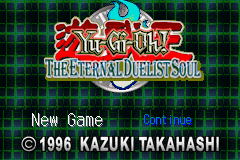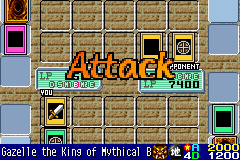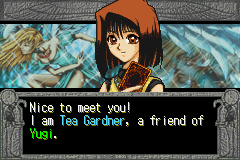When Yu-Gi-Oh first came to American shores I was 13 or 14, right in the target audience's age group, and oh boy, did I fall into it, hard. I was disillusioned with the Pokemon Trading Card Game's newest expansion packs, and, to be honest, at that time, the Pokemon Trading Card Game wasn't very fun. But Yu-Gi-Oh came out and blew the youth Trading Card Game market out of the water! Konami really hit a home run with a highly addictive card game that was simple to learn, but had nearly infinite complexity, even in it's early stages. In an arena dominated by Wizards of the Coast and Magic: The Gathering's rules, Yu-Gi-Oh came about with a truly fresh trading card game, that seemed to have no connection to the other popular games of the time, and it came with a Saturday Morning cartoon show with an engrossing story to boot. It's no wonder the game took off almost instantly!
When Eternal Duelist Soul hit the market, the Yu-Gi-Oh trading card game was still fairly new in America, with only a handful of expansion packs, and only three or four prefab decks. But this game packed every single card available at the time into the game, and gave us a portable, electronic version of the table-top game we all loved. Konami also released several Playstation games around this time, which were not related to the Yu-Gi-Oh trading card game, instead focusing on battling monsters, but with Eternal Duelist Soul, Konami took the route that the Pokemon Company had taken with its GameBoy Color version of its own trading card game, making a faithful port of a fun game into the portable market.
However, in contrast to the Pokemon Trading Card Game's electronic version, Konami opted to not include a story-driven quest. Instead, upon starting the game for the first time, you are greeted by one of Yugi Moto's friends, Tea Gardener. She will tell you that you need a deck to play, and have you choose from one of three decks.

You cannot see which deck contains which cards, so the selection is pretty random. She then explains some basics of the game to you, and you're sent to the main menu. Here you can select from several options, as seen below.

When you select Campaign mode you will be brought to the meat and potatoes of the game. Initially there are only five opponents for you to choose from, but as you beat them, more will eventually open up. Selecting any one of them will have them introduce themselves and their style of play. The first five opponents are friendly players who will play a relaxed game with you. This is a good chance for you to get cards to add to your deck. The opponents are all characters from the Yu-Gi-Oh TV show, and they have playing styles similar to their personalities in the show. They also have the same decks they do in the show, with the same cards. For instance, Mai Valentine has a deck featuring her Harpie Ladies so even before you challenge them you can know what to expect.
When starting a duel, you play Scissors, Paper, Rock to determine who goes first. Whoever wins selects if they want to be first or second, then the word DUEL drops in from the top of the screen. If you hold R and L at this time, the game will speed up some animations to make the game move a bit more quickly. This has no actual effect on gameplay, it's purely cosmetic.
After this you're dropped into the field of play, which is set up just like any Yu-Gi-Oh tournament mat, and you start your duel.

The first few enemies have very easy to see patterns of attack, but again, it's just a simple way to beat some people and add cards to your deck. When you beat an opponent, you will get to choose from a selection of expansion packs, each with different sets of cards in them. When you select one, five cards from the set will be randomly given to you, and added to your trunk. Once you have more cards to play with, you can start changing your deck in any way that you would if you were playing the real Yu-Gi-Oh Trading Card Game.
There are also a few other features to gain cards to play with. There is an in-game calender, which advances one day for each normal duel you participate in. Every "Saturday" you receive a copy of the Weekly Yu-Gi-Oh, a magazine with five randomly selected cards to add to your trunk. Unfortunately, there is no actual magazine for you to read, which is somewhat disappointing, though I suppose that there could only be so many articles, and after a while, reading them would get tedious.
Additionally, twice a month there is a dueling tournament, in which Solomon Muto will appear and talk to you a bit about the trading card game, then he will randomly select an opponent and forces you to play against them, best out of three. This allows you to utilize your side-deck more prominently, as between each bout you have the opportunity to switch out cards to help gain an edge against a certain type of opponent.
Another interesting way to gain cards is through the password system, which allows you to insert cards that you really own into the game! This helps you to advance your game early on if you already play the TCG, and have a style of play unique to you.
Additionally, this game features 1-on-1 link-cable support, but your friend must also have a cartridge to play with you. You can battle them or trade cards, which adds an interesting level of realism to the game.
The Deck Edit menu option is pretty self explanatory, but it provides a very nice and intuitive way to see the cards you have in your trunk, and to add them or remove them from your deck. You also have the option to sort through your cards by different criteria, and can filter the list to only see Magic cards, or Trap cards.
The graphics in this game are very simple, but in a way, it's almost better that way. Every pixel seems to serve a purpose, but the game still looks very nice. The art from the cards is the same as the art on the real cards, adding to the feel of actually playing the game. But, it still plays exactly like playing a card game, so don't expect monsters to start jumping out of the cards or anything. Although there are some instances where the game adds a bit of flair, just to make things more exciting.

The music is also very simple chiptunes, but it adds a nice sort of ambiance to the game's mechanics. The first few opponents have very light-hearted and fun music that emphisises how fun the game is, and as you fight more challenging opponents, the music slowly becomes more oppressive and dark. Over all, I'd say the musical selection in this game isn't something that I'd rush out to download, but I certainly enjoy hearing it in the game.
All in all, the game was a great venture into the handheld market for the Yu-Gi-Oh franchise, and one I still play to this day. Although the next game in the series improved many mechanics of the game, such as automatically increasing the speed of the animations, making holding R and L at the beginning of a duel unnecessary, this one will forever hold a special place in my heart, just for being the first. Or maybe it's because after the first set of expansions, I quit playing, and the newer ones feature cards I don't like...
 Lazlo Falconi is Offline
| ID: 531989 | 1304 Words
Lazlo Falconi is Offline
| ID: 531989 | 1304 Words
 Lazlo Falconi is Offline
Lazlo Falconi is Offline


 User Notice
User Notice 












